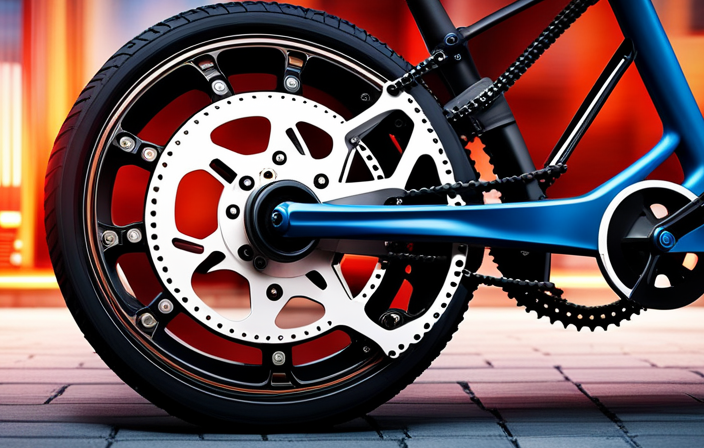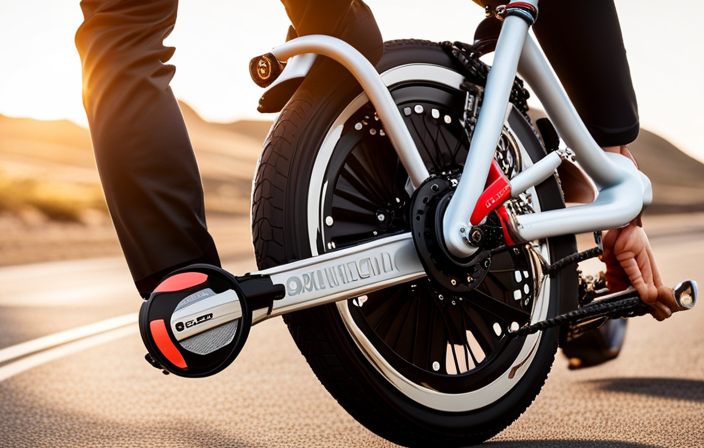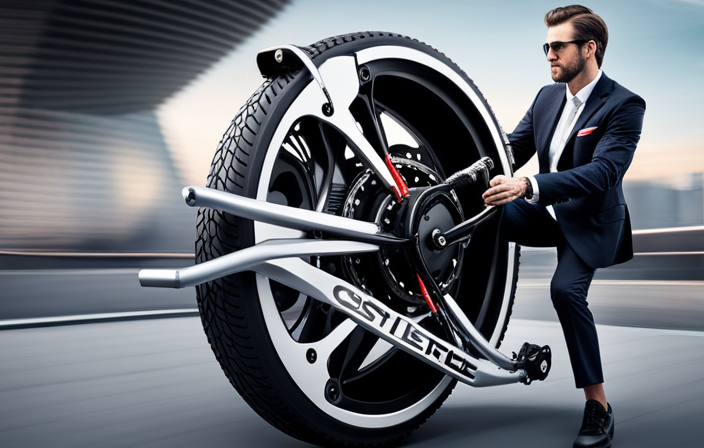Imagine this scenario: you are riding your electric bike, feeling the breeze in your hair and the thrill of the open road. Suddenly, disaster strikes – you experience a flat tire.
Don’t panic! In this guide, I’ll walk you through the step-by-step process of fixing a flat on your electric bike. With the right tools and a little know-how, you’ll be back on the road in no time.
So let’s dive in and get your wheels rolling again!
Key Takeaways
- Regularly check tire pressure and maintain recommended levels
- Promptly address any visible signs of tire damage, such as cuts or holes
- Use a patch kit or replace the inner tube for minor punctures
- Consider investing in puncture-resistant tires for added protection against flats
Gather the necessary tools and materials
You’ll need a few tools and materials to fix a flat on your electric bike. First, make sure you have a tire lever to remove the tire from the wheel. This will allow you to access the inner tube. You’ll also need a patch kit or a spare inner tube to replace the damaged one. In addition, having a bike pump or CO2 inflator will be necessary to inflate the new tube.
Choosing the right tire sealant is crucial to preventing flats on electric bikes. Look for a sealant that is compatible with your tire type and size. It should be able to seal punctures up to a certain diameter. Before applying the sealant, make sure to remove any debris from the tire.
Preventing flats on electric bikes can be done by using puncture-resistant tires. These tires have additional layers of protection to reduce the risk of punctures. Regularly checking the tire pressure and avoiding rough terrain can also help prevent flats.
So, gather your tools and materials, and let’s get started on fixing that flat!
Locate the source of the flat tire
First, try to identify where the puncture is on your e-bike tire. Start by inspecting the tire for any obvious signs of damage such as nails, glass, or sharp objects stuck in the rubber. If you can’t locate the puncture visually, you may need to use the ‘soapy water’ method.
Mix water with a small amount of dish soap and apply it to the tire surface. Look for bubbles forming, as this indicates the location of the leak. Another method is to submerge the tire in water and look for air bubbles escaping.
If these methods don’t work, you can also try inflating the tire and listening for any hissing sounds, which can help pinpoint the puncture.
By troubleshooting common issues with electric bike tires, you can quickly and effectively locate the source of a flat tire and proceed with the necessary repairs.
Remove the wheel from the electric bike
To remove the wheel from your e-bike, start by loosening the bolts or quick release mechanism securing it to the frame.
First, locate the bolts or quick release lever on the wheel axle. Use a wrench or your hands to loosen the bolts or open the lever.
Once loose, carefully slide the wheel out of the dropouts on the frame. Be cautious not to damage the brake rotor or derailleur in the process. If the wheel feels stuck, gently wiggle it back and forth to loosen it.
Once the wheel is free from the frame, set it aside in a safe place. Remember to disconnect any electrical connections if your e-bike has a motor hub in the wheel.
Removing the wheel is a critical step in accessing and fixing a flat tire on your electric bike.
Deflate the tire completely
Once the tire is fully deflated, proceed to the next step.
Before repairing a flat on an electric bike, it is essential to inspect the tire damage thoroughly. Look for any punctures, cuts, or foreign objects stuck in the tire. This step is crucial to determine whether the tire can be fixed with a sealant or needs to be replaced entirely.
If the damage is a small puncture, a tire sealant can be used to repair it. Tire sealants are designed to seal small holes and prevent air from escaping. To use the sealant, attach the sealant bottle to the valve stem and inject the recommended amount. Then, re-inflate the tire and give it a spin to distribute the sealant evenly.
This simple fix can save you time and money, getting you back on the road in no time.
Inspect the tire for any sharp objects or debris
After fully deflating the tire, it’s important to carefully inspect it for any sharp objects or debris. This step is crucial in identifying the cause of the flat tire and preventing future flats on your electric bike.
To start, visually examine the entire tire surface, looking for any nails, glass shards, or other sharp objects lodged in the rubber. Run your fingers along the inner and outer edges of the tire, feeling for any thorns or metal fragments that could puncture the tube. Additionally, check the tread for any embedded stones or gravel that could cause a flat.
Common causes of flat tires on electric bikes include riding over rough terrain, running over sharp objects, or simply having worn-out tires. By thoroughly inspecting your tire, you can address any issues and take proactive measures to prevent future flats.
Patch or replace the inner tube
You can either patch or replace the inner tube of your tire. When deciding between the two options, it is important to consider the pros and cons.
Patching the inner tube is a cost-effective solution and can be done quickly. However, it may not provide a long-term fix and may require multiple patches over time.
On the other hand, replacing the inner tube ensures a fresh and reliable tube, but it can be more expensive and time-consuming.
To patch the inner tube, start by locating the puncture and cleaning the area thoroughly. Apply a patch with adhesive, ensuring it is securely attached. Allow the patch to dry before re-inflating the tube and reinstalling it on the wheel.
When replacing the inner tube, remember to choose the correct size and valve type. Additionally, regularly inspecting your inner tube for wear and maintaining proper tire pressure are best practices for inner tube maintenance.
Reinstall the wheel onto the electric bike
To reinstall the wheel onto an e-bike, make sure it is securely aligned with the frame and tighten the axle nuts or quick-release skewer. Proper wheel alignment is crucial for optimal performance and safety.
Here are some key steps to follow when reinstalling the wheel:
-
Ensure the wheel is properly aligned with the frame by checking the position of the brake pads. They should be equidistant from the rim on both sides.
-
Align the axle of the wheel with the dropouts on the frame. The axle should fit snugly into the dropouts without any wobbling or misalignment.
-
Once the wheel is aligned, tighten the axle nuts or quick-release skewer. Use a wrench or your fingers to securely fasten them, ensuring the wheel is firmly in place.
-
Double-check the alignment and stability of the wheel by giving it a gentle spin and observing for any wobbling or rubbing against the brake pads.
-
Finally, test the brakes to ensure they are functioning properly before taking the e-bike for a ride.
By following these steps, you can successfully reinstall the wheel onto your electric bike, ensuring proper alignment and enhancing your riding experience.
Inflate the tire to the recommended pressure
First, make sure to check the recommended pressure and inflate the tire accordingly. To check the tire pressure, you can use a tire gauge or consult the electric bike’s manual.
Once you have determined the correct pressure, it’s time to inflate the tire. Grab a bike pump that is compatible with your electric bike’s valve type, which is typically either a Presta or Schrader valve. Attach the pump securely to the valve and begin pumping air into the tire. Keep an eye on the pressure gauge to ensure you reach the recommended pressure.
If you accidentally overinflate the tire, you can release some air by pressing the valve pin. Once the tire is properly inflated, give it a quick check to make sure there are no visible punctures or damage.
Test the tire to ensure it is properly fixed
Next, make sure you give the tire a thorough inspection to ensure it is securely fixed.
Start by testing the tire pressure to ensure it is at the recommended level. Use a tire pressure gauge to measure the pressure and compare it to the manufacturer’s specifications. If the pressure is too low, inflate the tire to the recommended level using a bike pump.
Once the tire is properly inflated, check for any punctures. Carefully examine the tire surface, looking for any visible signs of damage such as cuts, holes, or embedded objects. If you notice any punctures, it is important to address them promptly. Use a patch kit or replace the inner tube if necessary.
By testing the tire pressure and checking for punctures, you can ensure that your electric bike tire is properly fixed and ready for your next ride.
Maintain regular tire maintenance to prevent future flats
Regular tire maintenance is essential for preventing future punctures. To ensure the longevity of your electric bike’s tires, consider implementing these preventive measures:
-
Keep your tires properly inflated: Maintaining the recommended tire pressure is crucial in preventing flats. Underinflated tires are more susceptible to punctures due to increased friction and heat generated while riding.
-
Inspect your tires regularly: Examine your tires for any signs of wear and tear, such as cracks, bulges, or embedded debris. Remove any foreign objects that could potentially cause a puncture.
-
Use puncture-resistant tires: Consider investing in puncture-resistant tires, specifically designed to minimize the risk of flats. These tires feature thicker rubber and reinforced sidewalls, providing added protection against sharp objects on the road.
By following these preventive measures, you can significantly reduce the chances of experiencing a tire puncture on your electric bike. Remember, a little maintenance goes a long way in ensuring a smooth and hassle-free ride.
Frequently Asked Questions
How do I know if my electric bike tire is flat?
To know if your electric bike tire is flat, visually inspect the tire for any signs of deflation or damage. Additionally, you can check the tire pressure using a pressure gauge. Regularly maintaining proper tire pressure and choosing the right tire can help prevent flat tires.
Can I use a regular patch kit to fix a flat on an electric bike tire?
Yes, you can patch an electric bike tire using a regular patch kit. However, it’s important to ensure it’s safe. Follow proper instructions, use a high-quality patch, and check for any damage to the inner tube.
How often should I check my electric bike tires for flats?
I should check my electric bike tires for flats at least once a week. To prevent flats, I should maintain proper tire pressure, avoid sharp objects, and use puncture-resistant tires or tire liners.
What is the recommended tire pressure for an electric bike?
The recommended tire pressure for an electric bike is typically between 40 to 60 psi. Maintaining proper tire pressure is crucial as it improves efficiency, provides better traction, and prevents flats, making your ride smoother than gliding on a cloud.
Are there any additional precautions I should take when fixing a flat on an electric bike compared to a regular bike?
When fixing a flat on an electric bike, it is essential to take additional precautions and safety measures. This includes disconnecting the battery, being mindful of the electrical components, and properly reassembling the bike after the repair.
Conclusion
In conclusion, fixing a flat on an electric bike is a straightforward process that anyone can do with the right tools and materials. By following the steps outlined in this article, you can quickly and easily get back on the road in no time.
One potential objection may be that fixing a flat tire is too difficult for someone without much mechanical experience. However, with the step-by-step instructions provided, even those with limited knowledge can successfully fix a flat tire on their electric bike.
So don’t let a flat tire stop you from enjoying your ride, give it a try and get back to pedaling!









